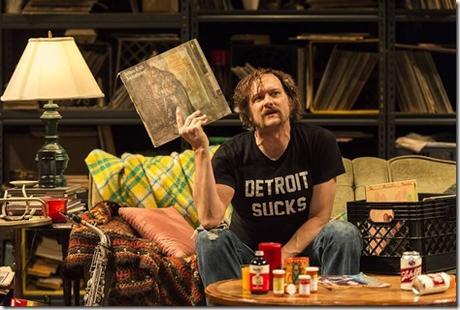
Jensen loses himself in the role of Lester Bangs, warts and all

Rock critic Lester Bangsdidn't live long - he died at 33 after overdosing on cough syrup - but his short career chronicling the gods of rock and roll had lasting impact. Even before his cameo (as played by Philip Seymour Hoffman) in "Almost Famous," Bangs' counter-culture criticism had enshrined him as a "truth teller" - someone whose uncompromising honesty and unwillingness to sell out made him a unicorn in the business, an influencer who could not be bought by the corrupt corporate interests that mollified the masses and killed the purity of rock and roll.

That doesn't make How to Be a Rock Critic - or Bangs - any easier to stomach. With a script that draws from Bangs' writing, How to Be a Rock Critic reveals Bangs core character early on: He's the kind of man who stands silently by and watches as a bleeding, sobbing young woman is gang raped and beaten bloody by a group of Hells Angels. Actually, Bangs did do something about the horrific crime. He wrote about it. In How to Be a Rock Critic , it's an anecdote that helps establish Bangs' tortured-artist persona.
Throughout the 90-minute show, Bangs is depicted first and foremost as as an iconoclast, a brilliant writer and a man who never caved to the shallow whims of popular culture and the commodification of rock. As for that time he witnessed a gang rape? He exonerates himself completely. "What was I supposed to do? Take on a room full of sadistic, drunk Hells Angels?" Bangs asks after the scene plays out. I can answer that: You could have left and called the cops, asshole. Instead, you used a woman's brutalization as a colorful chapter in your trunk of stories about your crazy life as the world's only honest rock critic.
The Hells Angels scene comes relatively early in How to Be a Rock Critic , but it's not a one-time episode. Later in How to Be a Rock Critic , Bangs sits by in a hotel room while an adoring teenage groupie is savagely raped by the rockstars he venerates.

You could argue that Bangs is hardly the only great writer who was reprehensible in his life away from the page. The world is filled with great artists who are not great people. If only the art of upright people were acknowledged, we'd have a world stripped bare of most literature, paintings, plays and music. But here's the thing about Bangs: The work he reveals in How to Be a Rock Critic is far from great. It's more angry than revelatory.
The reviews we hear in How to Be a Rock Critic come off as the screeds of an adolescent boy who wants to piss everybody off just for the sake of sticking it to the man. It's the rantings of a kid who comes home for Thanksgiving with a Mohawk and a safety pin through his cheek, not because he especially likes Mohawks and facial piercings but because he knows the look will make his parents angry and brand him as different from all the suburban sheeple in his cul-de-sac.
And for someone who prided himself on being anti-corporate everything (he hated the Stones and the Beatles) , Bangs has no trouble praising Elvis (he possessed something of "the infinite") and the Carpenters (Karen had "a purity.")
For all his grungy, gritty populism, there's an elitist quality to Bangs too. At one point, he talks about Manhattan and declares that the only place in the entire world worth living in is "below 14th Street." It's the pronouncement of someone who is just too cool for school, a forerunner to the hipster who insists the only good bands are the ones you've never heard of. It's part and parcel of a script that makes Bangs seem like a pretentious jerk with a huge chip on his shoulder.

How, Bangs asks early in the show, could a piece of mass-produced vinyl change the world? He never answers that question, leaving audiences to conclude that it might not be answerable. He certainly doesn't answer it in the snippets of reviews the audience hears as Bangs goes from Rolling Stone to Creem to the Village Voice.
Jensen all but disappears into the role, giving a performance that is exhaustively committed. He makes Bangs a whirling dervish of nervous energy, twitching as he gulps down cough syrup while delivering an almost non-stop barrage of thoughts and ideas while frantically playing cuts from his massive record collection. In one scene, he attacks the typewriter with the ferocity of Pete Townshend smashing a guitar.
Jensen shows Bangs as driven, anguished, wholly self-absorbed and so steeped in music that it feels incorporated into his body on a cellular level. He's on a quest, even if he doesn't know what he's looking for.
Set designer Richard Hoover creates a living room that looks so authentically grungy you may want to wash your hands after the show. It's littered with records, cough syrup bottles, and the detritus of a man for whom things like eating and hygiene aren't important.
Almost 35 years after his death, Bangs is a venerated figure who looms large in the history of rock. He plays straight into the bad boy stereotype that fuels the myths of rock stardom. And so does How to Be a Rock Critic .
How to Be a Rock Critic continues through July 22nd at Steppenwolf's 1700 Theatre, 1700 N. Halsted (map), with performances Thursdays & Fridays at 8pm, Saturdays 3:30pm & 8pm. Tickets are $30, and are available by phone (312-335-1650) or online through their website (check for availability of ). More information at Steppenwolf.org. (Running time: 90 minutes, no intermission)

Photos by Craig Schwartz
behind the scenes
Jessica Blank (director), Richard Hoover (set design), (lighting design), David Robbins (sound design), P. Carl (dramaturgy), Mary K. Linger (stage manager), Justin A. Partner (associate designer, production manager), ArKtype, Thomas O. Kriegsmann (co-producers), Craig Schwartz (photos)
Tags: 17-0704, 1700 Theatre, ArKtype, Catey Sullivan, Chi Chu, Chicago Theater, Craig Schwartz, David Robbins, Erik Jensen, Jessica Blank, Jessica Blanks, Justin A. Partner, Lester Bangs, Mary K. Linger, P. Carl, post, Richard Hoover, Steppenwolf Theatre, Steppenwolf Theatre Lookout Series, Thomas O. Kriegsmann

